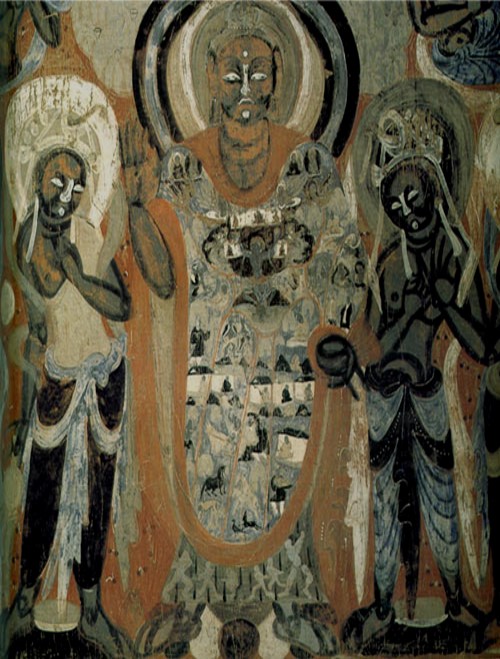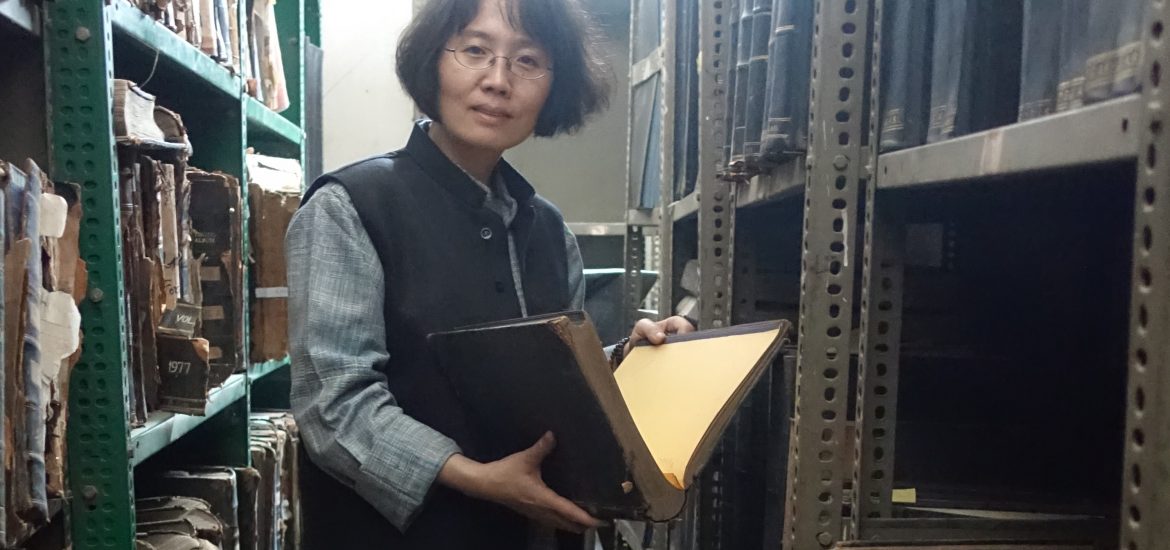This year’s Tung Lin Kok Yuen Online Lecture Series on Buddhist Art, hosted by The University of Hong Kong’s Center of Buddhist Studies (HKU CBS) is hosting Dr. Tianshu Zhu for two talks. Tianshu is a scholar at the University of Macau. She earned her PhD at The Ohio State University and has a large range of research interests, from Buddhist art in India, Central Asia, and China to Buddhist meditation and ritual practice. Her current research spans protective deities in Buddhist art and practice, temples in Macau, and popular religion in the Guangdong region.
The first talk (8 July, 18:30–20:30 HKT) is about “Placing the Cosmos Worlds inside a Buddha’s Body – The Iconographies of Dharmadhatu 法界 Buddha Images.” In her abstract, she notes that, “One of the most fascinating and complex iconographies of Buddha images in China is a type of images depicting Buddhist cosmological structures and various type of beings on the Buddha’s body. This is the so-called ‘cosmological Buddha,’ in Sanskrit the dharmadhātu (Dharma-realm) Buddha image, or fajie da xiang (法界大像) by the Chinese inscription.” This means “a large image of the dharmadhātu.”
This is a unique genre of art of the Buddha that was found mainly in central China and the oasis kingdom of Khotan. The iconography was popular after the middle of the 6th century and endured until the Liao (907–1125) and Song (960–1127) Dynasties. It is related to the fundamental question of Mahayana iconography. This question is simply: “Where is the Buddha?”

For Theravada Buddhists, the answer was simple: the Buddha was traceless, completely gone from this world, but he had a definitive physical presence through his relics and the stupas enshrining those relics in Asia and elsewhere. The Dharmadhatu Buddhas, or Cosmological Buddhas, reflect a Mahayana theological and philosophical perspective about the Buddha’s presence in everything, in the cosmos. It is not simply a “physical” presence, one that could lead to speculations of panentheistic thought in Mahayana. Rather, Tianshu argues that “this iconography was developed in strong association with the doctrine of the Tathāgatagarbha (womb of the Tathāgata) (如來藏) which became fundamental to Mahayana doctrine and its diverse schools.”
Entire dissertations, notes Tianshu, have been written about the identity of this mysterious genre of Buddha images. After all, in the Mahayana Buddhist traditions from China and Khotan, the cosmic Buddha is commonly known to be Vairocana, yet due to the art inside the Dharmadhatu Buddha’s physical body being clearly of Mount Meru, a case has also been made for his identity to have been Shakyamuni Buddha. Mount Meru is, after all, the cosmological center of the world of Saha, Shakyamuni’s world-system. “In other words, we have a longstanding debate about whether the Cosmological Buddha takes its doctrinal or textual cues from the Avatamsaka Sutra, or the Lotus Sutra,” noted Tianshu. “But we also need to be very careful to distinguish these Dharmadhatu Buddhas as a separate, independent genre of iconography. The inscriptions of these Buddhas clearly denote: ‘Dharmadhatu Buddha,’ not Shakyamuni or Vairocana.” They also coexisted with images of Vairocana and Shakyamuni, which were being simultaneously commissioned and created as the centuries passed.
One major problem is how we can explain every element, which is extremely hard to do. A further difficulty is that in Chinese Buddhist art, any generic Buddha image can represent a given Buddha. Identifying specific Buddhas without the aid of clear inscriptions or mudras is extremely difficult. This is compounded by the Trikaya doctrine, which states that all Buddhas share the same primordial, unconditioned “truth-body” of the Dharmakaya. Tianshu has attempted a different approach, which is to carve out this new concept of the Dharmadhatu Buddha as independent of the individual Buddha’s potential identity – in other words, the Cosmological Buddha could contain Mount Meru, or any other cosmic region: the Dharmadhatu Buddha’s artists are attempting to explain the true nature of the Buddha as a presence.
I asked her why she picked this topic for her time with CBS, and she says that she has worked on this project for years, having started since at least 2009. “I picked this as something to discuss because it has an academic focus but can also touch a general audience, including those curious about Buddhist art. In some ways, this area of research was my own kind of practice,” she observes somewhat wryly. “In this extremely long process, I went through my own struggles and disappointments, and along the way, underwent a certain kind of purification.” Cleansing oneself, undergoing the study of a profound iconography of this Cosmological Buddha – perhaps the presence was with Tianshu, and with us all, after all.
See more
ZHU, Tianshu 朱天舒 (University of Macau)



Wonder if the trikaya and tathagatagarbha in some way relate to sunnyata, dharmakaya and quatum zero field, and sambhogaya or the light body emanating from that void, and the physical body or nirmanyakaya coming out of the womb of lightbody….. just a thought.
Very interesting observation. They definitely are in the sense that they have sometimes been used interchangeably (particularly Dharmakaya and Tathagathagarbha), but they are different aspects of the enlightened, unconditioned nature. The relationship between the Three Bodies is also a very beautiful relationship to visualize.
Raymond Lam